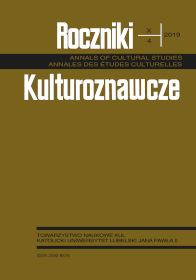Emotions as an Element of the Local Government Message Structure on Facebook.com: Case Study of the Official Profile of the Capital City of Warsaw
Abstract
Social networking sites are an increasingly important communication tool for public institutions. Local governments (municipalities—cities) create official social profiles to reach not only their residents, but also tourists and investors. They publish content of diverse nature and content. The author's research shows that this message can be categorized. Each type of content brings not only a portion of information, but some categories of posts contain elements that are designed to arouse emotions and at the same time involve users of the local government profile. Such a message may increase the scope of publication. The author presents the results of his research showing that the local government prefers content that can initiate increased emotional interaction of Facebook.com users. The case study (Warsaw official profile) is an attempt to identify those elements of the message structure (posts) that may arouse online expression in the form of „likes”, comments or „sharing”.
References
Bazarova, Natalya, Yoon Choi, Victoria Schwanda Sosik, Dan Cosley, & Janis Whitlock. „Social Sharing of Emotions on Facebook”. CSCW ’15: Proceedings of the 18th ACM Conference on Computer Supported Cooperative Work & Social Computing, February 2015, 154–164. DOI: https://doi.org/10.1145/2675133.2675297.
Boyd, Danah M., & Nicole B. Ellison. „Social Network Sites: Definition, History, and Scholarship”. Journal of Computer — Mediated Communication, 13, Issue 1 (October 2007): 210–230. DOI: https://doi.org/10.1111/j.1083-6101.2007.00393.x.
Booth, Robert. „Facebook reveals news feed experiment to control emotions”. The Guardian. Dostęp 12.12.2019. https://www.theguardian.com/technology/2014/jun/29/facebook-users-emotions-news-feeds.
„Cambridge Analytica”. Forbes. Dostęp 12.12.2019. https://www.forbes.pl/cambridge-analytica.
Chabrzyk, Agnieszka, & Julia Kałużyńska, Przemysław Rosa, Andrzej Suhov, & Monika Turek. „Facebook”, Przewodnik po social media w Polsce 2019/2020, iab Polska 2019, 6. Dostęp 01.01.2020. https://iab.org.pl/wp-content/uploads/2020/01/IAB-Przewodnik-po-Social-Media-w-Polsce-2019-2020.pdf.
Cohen, Elizabeth, & Alexander Lancaster. „Individual differences in in‐person and social media television coviewing: The role of emotional contagion, need to belong, and coviewing orientation”. Cyberpsychology, Behavior, and Social Networking, 17(8) (2014): 512–518. DOI: https://doi.org/10.1089/cyber.2013.0484
„Emotikon”, Wielki słownik języka polskiego. Dostęp 12.12.2019. https://wsjp.pl/index.php?id_hasla=57204&ind=0&w_szukaj=emotikon.
„Definition of emoji”. Słownik Merriam-Webster. Dostęp 12.12.2019. https://www.merriam-webster.com/dictionary/emoji.
Harding, Jenifer, & E. Deidre Pribram (red. Emotions: A cultural studies reader. London: Routledge, 2009.
„Hasztag”. Wielki słownik języka polskiego. Dostęp: 12.12.2019. https://wsjp.pl/index.php?id_hasla=86506&ind=0 &w_szukaj=hasztag+.
Hocking, John E., Duane G. Margreiter, & Cal Hylton. „Intra‐audience effects: A field test”. Human Communication Research, 3(3) 1977, 243–249. DOI: https://doi.org/10.1111/j.1468-2958.1977.tb00522.x.
Kemper, Theodore D. „How Many Emotions Are There? Wedding the Social and the Autonomic Components”. American Journal of Sociology 93, no. 2 (1987): 263–289.
Kowalik, Krzysztof. „Dialog, monolog, interakcja? Portal społecznościowy jako kanał komunikowania online samorządu gminnego. Studium przypadku miasta Kielce”. Naukowy Przegląd Dziennikarski nr 3 (78) (2018): 7–25.
Kowalik, Krzysztof. „‘Dystrybucja emocji’ jako forma komunikacji samorządów lokalnych w serwisie Facebook.com. Próba kategoryzacji przekazu w kontekście public relations”. Studia Medioznawcze 3 (74) (2018): 51-63. DOI: https://doi.org/10.33077/uw.24511617.ms.2018.3.54.
Kowalik, Krzysztof. „Media online samorządów lokalnych — nowa struktura w systemie medialnym. Próba ujęcia in statu nascendi”. Zeszyty Prasoznawcze 61, nr 3 (235) (2018): 429–448.
Kowalik, Krzysztof. „Obowiązki informacyjne samorządu lokalnego w epoce mediów społecznościowych oraz trendy w implementacji w serwisach WWW kanałów dystrybucji informacji. Studium przypadku gmin świętokrzyskich”. Rocznik Bibliologiczno-Prasoznawczy nr 10 (21) (2018): 119–135.
Kowalik, Krzysztof. „Serwisy społecznościowe w komunikacji samorządów lokalnych. Studium przypadku”. Naukowy Przegląd Dziennikarski nr 4 (24) (2017): 113-129.
Kowalik, Krzysztof. „Use of Information and Communication Technologies in Official Websites of Gminas. Are the Polish Rural and Rural-Urban Local Governments Prepared to Communicate with the Younger Generation — Digital Natives, Generation Y?”. Public Administration Issues no. 5, 2019: 140–154. DOI: https://doi.org/10.17323/1999-5431-2019-0-5-140-154.
Kramer, Adam D.I., Jamie E. Guillory, & Jeffrey T. Hancock. „Experimental evidence of massive-scale emotional contagion through social networks”. PNAS 111 (24) (June 17, 2014): 8788-8790. DOI: https://doi.org/10.1073/pnas.1320040111.
Krämer, Nicole C., German Neubaum, & Sabrina C.A. Eimler. „Brief History of (Social) Cyberspace”. W: Cyberemotions. Collective Emotions in Cyberspace, red. Janusz A. Hołyst, 11-35. Switzerland: Springer, Cham, 2017. DOI: https://doi.org/10.1007/978-3-319-43639-5.
Krippendorf, Klaus. Content analysis an introduction to its methodology, 18-21. Thousand Oaks, London, New Delhi: SAGE, 2004.
Lin, Ruoyun, & Sonja Utz. „The emotional responses of browsing Facebook: Happiness, envy, and the role of tie strength”. Computers in Human Behavior 52 (November 2015): 29–38. DOI: https://doi.org/10.1016/j.chb.2015.04.064.
Matz, Sandra, Michal Kosinski, Gideon Nave, & David J. Stillwell. „Psychological targeting as an effective approach to digital mass persuasion”. PNAS 114 (48) (November 28, 2017): 12714-12719. DOI: https://doi.org/10.1073/pnas.1710966114.
McQuail, Denis. Teoria komunikowania masowego. Warszawa: Wydawnictwo Naukowe PWN, 2007.
Meyrowitz, Joshua. „Medium theory”. W: The Sage handbook of media processes and effects, red. Robin L. Nabi & Mary Beth Oliver, 517–530. Los Angeles: Sage, 2009.
O’Reilly, Tim. „What is Web 2.0. Design Patterns and Business Models for the Next Generation of Sotware”. O’Reilly.com. Dostęp 12.11.2019. http://www.oreilly.com/pub/a/web2/archive/what-is-web-20.html?page=1.
„Polski internet w grudniu 2019”. Polskie Badania Internetu. Dostęp: 12.01.2020. http://pbi.org.pl/badanie-gemius-pbi/polski-internet-w-grudniu-2019/.
Porębski, Mieczysław. Ikonosfera, 144-145. Warszawa: PIW, 1972.
Post informacyjny [zrzut ekranowy, gdyż post został usunięty z profilu samorządu]. Dostęp: 29.09.2019. https://drive.google.com/file/d/1pDCRgO2zsDR9wwdo0Z3zsPLtWxl4byaC/view?usp=sharing
Post partycypacyjny. Dostęp 27.09.2019. https://www.facebook.com/warszawa/videos/241861060074222/
Post zaproszenie. Dostęp 28.09.2019. https://www.facebook.com/warszawa/videos/403878567170924/
Rimé, Bernard. The Social Sharing of Emotion in Interpersonal and in Collective Situations Cyberspace. W: Cyberemotions. Collective Emotions in Cyberspace, red. Janusz A. Hołyst, 53-69. Switzerland: Springer, Cham, 2017. DOI: 10.1007/978-3-319-43639-5
„Samorząd terytorialny w Polsce”. administracja.mswia.gov.pl. Dostęp 12.01.2010. http://admi nistracja.mswia.gov.pl/adm/baza-jst/843,Samorzad-terytorialny-w-Polsce.html.
Silverman, David. Interpretacja danych ilościowych. Przełożyły Małgorzata Głowacka-Grajper & Joanna Ostrowska, 59–62. Warszawa, Wydawnictwo Naukowe PWN 2008.
Smith, Kenneth L., Sandra Moriarty, Keith Kenney, & Gretchen Barbatsis. Handbook of visual communication. Theory, methods, and media. New Jersey, London: Lawrence Erlbaum Associates, Inc., Publishers, 2005.
Vincent, Jane, & Leopoldina Fortunati (red.). Electronic emotion: the mediation of emotion via information and communication technologie. Oxford: Peter Lang, Internationaler Verlag der Wissenschaften, 2009.





